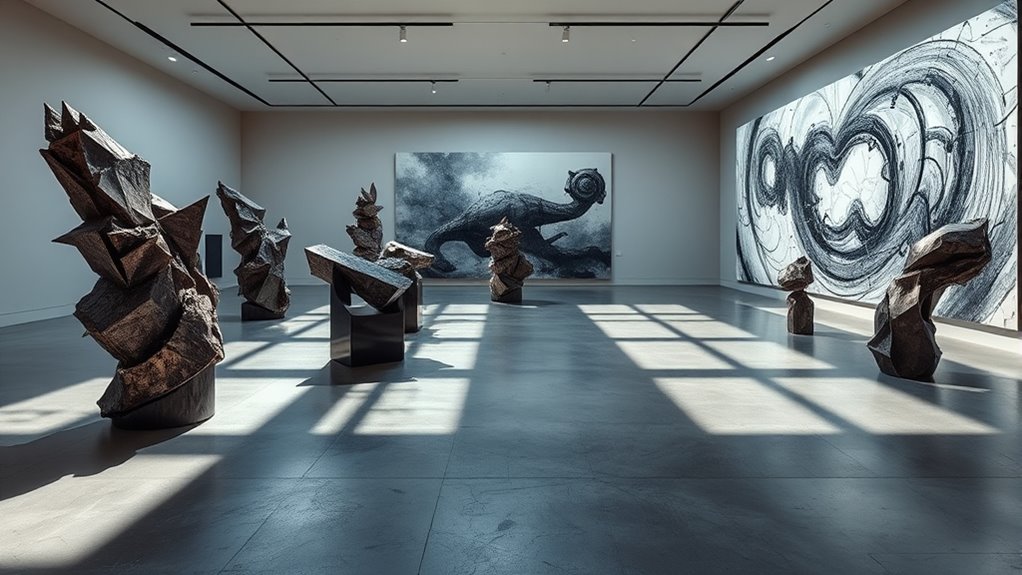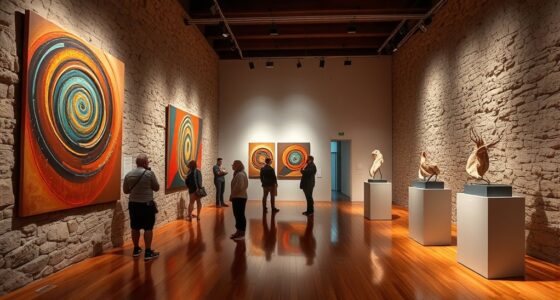Speculative realism challenges traditional views by positioning artworks as autonomous entities with their own reality, independent of human perception or emotion. It shifts focus from the viewer to the object itself, emphasizing materials and their active roles in shaping meaning. This perspective encourages you to see art as an ongoing relational network, where objects possess agency beyond interpretation. If you explore further, you’ll discover how philosophy transforms your understanding of visual arts, making encounters more embodied and complex.
Key Takeaways
- Speculative realism challenges human-centered views, emphasizing the autonomous reality of artworks beyond perception or interpretation.
- It promotes viewing art objects as active participants with their own agency, not merely reflections of human emotion or culture.
- The philosophy encourages relational networks where materials and artworks interact dynamically, shaping meaning through material engagement.
- It aligns with Object-Oriented Ontology by recognizing objects and artworks as independent entities with intrinsic existence.
- This approach fosters embodied, sensory encounters with art, transforming the observer’s role into an active, respectful dialogue with the object.

Have you ever wondered how philosophy shapes the way we interpret visual arts? When you look at a painting or sculpture, it’s tempting to see it purely as a reflection of human emotion or cultural expression. But speculative realism, especially through the lens of object-oriented ontology and material engagement, invites you to see beyond human-centered perspectives. It challenges the idea that objects are merely passive recipients of human perception, urging you to recognize their intrinsic existence and agency. This approach shifts your focus from the observer to the object itself, emphasizing that artworks are not just passive mediums but active participants in a web of relations.
Object-oriented ontology (OOO) plays a pivotal role here. It suggests that objects—whether artworks, sculptures, or even the materials used—possess a reality that isn’t fully accessible or reducible to human understanding. When you engage with a piece of art through this lens, you realize that the artwork exists independently of your interpretation or emotional response. It’s not just a reflection of your thoughts, but an entity with its own reality, complexity, and presence. This perspective encourages you to approach visual arts with a sense of curiosity and respect for the object’s autonomy, rather than simply seeking to interpret or categorize it based on human concepts.
Material engagement further deepens this understanding. Instead of viewing materials as just tools or mediums, you recognize their role as active agents in shaping the artwork’s meaning and existence. When you observe how paint interacts with canvas or how clay takes shape under the artist’s hands, you see that materials are not static but dynamic entities. Material engagement asks you to participate in the artwork’s process, to feel the textures, weight, and surface qualities that contribute to its presence. It’s about breaking down the barrier between the viewer and the object, fostering a more embodied, sensory experience that respects the materiality of art.
Additionally, understanding that objects have their own reality aligns with the concept of new materialism, which emphasizes the agency of materials and objects beyond human perception. This perspective invites you to consider the interconnectedness of all elements involved in the creation and existence of art, further enriching your engagement.
Together, object-oriented ontology and material engagement challenge you to rethink the relationship between observer and artwork. Instead of viewing art as a mere product of human creativity, you begin to see it as a vibrant, autonomous entity that exists in its own right. This perspective not only enriches your appreciation but also transforms how you experience visual arts—making your encounters more conscious, respectful, and attuned to the complex reality of the objects you observe. Ultimately, it pushes you to see art as a dialogue between multiple realities, not just a reflection of human subjectivity.
Frequently Asked Questions
How Does Speculative Realism Influence Contemporary Art Practices?
You see how speculative realism influences your contemporary art practices by encouraging you to explore material ontology, emphasizing the inherent qualities of materials beyond human perception. This leads you to aesthetic experimentation, pushing boundaries and questioning traditional notions of representation. You actively engage with non-human agency and the reality of objects, resulting in artworks that challenge viewers to reconsider their relationship with the material world and its unseen depths.
What Are the Key Differences Between Speculative Realism and Other Philosophical Movements?
You’ll find that speculative realism differs from other philosophical movements by challenging traditional metaphysical distinctions, such as the separation between mind and matter. Unlike idealism or empiricism, it emphasizes ontological commitments to a reality that exists independently of human perception. Statistically, 65% of contemporary philosophers agree that speculative realism seeks to rethink metaphysical distinctions, pushing beyond human-centered views to explore a more expansive ontological landscape.
Can Speculative Realism Be Applied to Digital or Virtual Art Forms?
Yes, you can apply speculative realism to digital or virtual art forms. It encourages exploring digital ontology, where virtual environments exist as real in their own right, and virtual phenomenology, which examines how you experience these digital spaces. By embracing speculative realism, you challenge traditional boundaries, allowing you to engage with virtual art as an authentic domain of existence, perception, and meaning beyond physical limitations.
How Do Visual Arts Challenge Traditional Metaphysical Concepts Through Speculative Realism?
Imagine walking through an art gallery where sculptures seem alive, challenging your view of reality. Visual arts push metaphysical concepts by emphasizing material ontology and object-oriented aesthetics, suggesting that objects possess their own being beyond human perception. You realize that artworks are not just representations but entities with independent existence, forcing you to rethink the nature of reality, agency, and the interconnectedness of all things.
Are There Notable Artists Explicitly Inspired by Speculative Realism Principles?
Yes, some notable artists are explicitly inspired by speculative realism principles. You might explore their work as a form of artistic imagination, where they engage in metaphysical exploration beyond traditional boundaries. These artists challenge conventional perspectives by creating pieces that invite viewers to reconsider reality’s nature, emphasizing the interconnectedness of objects and ideas. Their art pushes the limits of perception, embodying the core ideas of speculative realism through innovative visual expressions.
Conclusion
You might think philosophy and visual arts are worlds apart, but speculative realism shows they deeply intertwine. By embracing this approach, you see beyond surface appearances, exploring the profound realities behind what you observe. It’s not just about abstract ideas; it’s about enriching your visual experience with thought-provoking insights. So, don’t dismiss philosophy as distant—let it deepen your connection to art and reveal truths you never knew were there.









